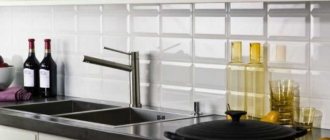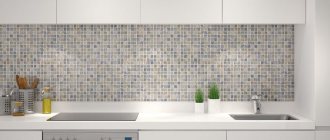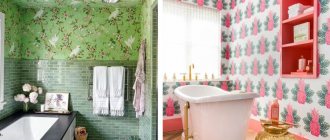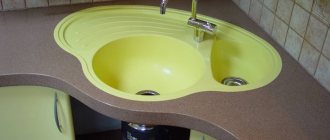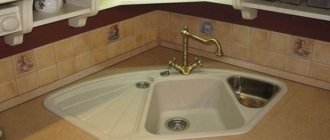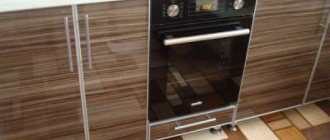Every year, porcelain stoneware floor tiles are used more and more often for kitchen tiling. Why has this material become so popular, what qualities allow it to be used in rooms with high humidity and other difficult operating conditions? You will learn about this, as well as which porcelain tile to choose for the kitchen, and how to lay it in this article.
The porcelain stoneware floor in the kitchen has all the characteristics necessary for this room
Specifics of porcelain stoneware, its advantages
Porcelain tiles are included in the category of ceramic finishing materials. But it has certain differences from traditional tiles. The structure of these types of finishes is similar, however, the production technology of porcelain stoneware is specific. Its production involves pressing and firing at elevated temperatures. These operations ensure solidity and absence of pores. The material is durable; moisture practically does not penetrate into it, even if the porcelain stoneware is in water.
Porcelain tiles are durable
The high density and homogeneity of the material makes it resistant to mechanical stress. These tiles do not chip, and contact with a sharp object does not leave scratches. In addition, porcelain tiles:
- does not lose properties under ultraviolet rays;
- completely retains the structure during temperature changes;
- inert to chemicals.
These properties guarantee the finish a long service life. You can lay porcelain tiles on the kitchen floor without hesitation, without fear of damage to the coating from regular washing, accidental falling of heavy objects, or the use of household chemicals.
Porcelain tiles guarantee a long service life for the finish
Porcelain tiles for the kitchen and hallway: which one to choose?
For the above premises, it is very important to choose impact-resistant tiles. This property makes porcelain stoneware superior to other floor coverings. It does not lose color because it comes from the depths. It is indifferent to moisture, because its water absorption is close to zero.
No less important is the slip rate. You should pay attention to it at the stage of purchasing flooring. Porcelain tiles with anti-slip levels R10 and R11 are suitable for the kitchen and hallway.
You should take into account the fact that most anti-slip tiles have irregularities called relief. Over time, a large amount of dirt accumulates in these small cracks, which is difficult to access and difficult to remove. Therefore, it is advisable to choose tiles of dark colors, because light ones quickly become dirty and acquire an unpleasant tint. If the desire to buy a beige or white floor covering is stronger than the reluctance to constantly clean the floor with abrasive substances and a stiff brush, you can safely go to the checkout. Those for whom practicality is more important should choose darker textured tiles.
The same can be said about light-colored “seams” as about tiles - after a short period of time they will get dirty. Therefore, for the kitchen and hallway it is worth choosing a less easily soiled grout.
The next question is: how many tiles should I buy? The answer depends on the area of the surface being tiled, the size of the slabs and the installation method. Experts recommend purchasing porcelain stoneware with a small margin of +10-15%.
Matte porcelain tiles are considered the best option for the kitchen and living room. It has all the qualities necessary for these premises: it does not slip even when wet, it is durable and wear-resistant, and is also easy to clean and wash. Technical porcelain tile is also quite good in care and use, but it creates a less attractive decor, and its color range is somewhat poor.
The use of porcelain stoneware in the kitchen interior
The kitchen can be considered one of the most complex rooms in the house. The choice of materials for it requires a careful approach. Using a finish that is not able to withstand difficult tests will cause a premature loss of attractiveness and the need to make repairs again soon. Porcelain tiles eliminate such problems. This material is ideal for such conditions.
Durable, durable porcelain tiles are ideal for kitchen floors. The coating will fully retain its qualities when:
- regular washing using chemicals;
- falling heavy objects;
- contact with hot water, fat;
- exposure to direct sunlight.
Porcelain tiles retain their qualities when exposed to hot water and grease.
The material does not allow moisture to pass through. Even if, if the plumbing equipment is damaged or for other reasons, water spills on the floor, this will not cause claims from the neighbors below.
The range of these tiles is extensive. You can choose porcelain stoneware for the kitchen floor and walls, and buy an original, reliable sink made from this material. The variety of tile decor makes it possible to choose options to implement any design idea.
A variety of decor makes it possible to choose tiles to suit any interior
An important advantage of the material is its environmental friendliness. It contains no ingredients that can cause harm to health. You can use porcelain tiles for the kitchen floor if people prone to allergic reactions live in the house. This coating does not pose any danger to them. The material contains kaolin clay, quartz powder, mineral pigments, and metal oxides. These are natural ingredients that are safe for humans and animals.
Advantages and disadvantages
Tiles and porcelain tiles have some similar features. They are similar both in appearance and in composition, but the production technologies of these two materials differ. The structure of porcelain stoneware, unlike tiles, is not porous; it does not have internal voids or microcracks. This means that this material will be more durable and reliable in operation. It is not afraid of sudden changes in temperature, high humidity, acids and household chemicals do not have a negative effect on it.
Another significant difference from tiles is the degree of painting. Ceramic tiles are painted only on top, and porcelain tiles are painted throughout their entire thickness, since during production dyes and plasticizers are added to the clay immediately. This allows small chips to remain unnoticeable, which means they will not spoil the appearance of the floor covering and the interior as a whole.
Like any finishing material, porcelain stoneware for kitchens has its strengths and weaknesses, which you need to know about before deciding to purchase. Also, do not ignore reviews about various manufacturers of this coating.
Among the advantages of the material are:
- Strength. This coating can withstand a weight of 200 kilograms. This means that a refrigerator and a kitchen set with built-in household appliances will not cause him any harm.
- Moisture resistance. The material does not have a porous structure, which means that even liquid spilled on the floor will not be absorbed. Therefore, porcelain stoneware will be the best option for use in the kitchen, bathroom and other rooms with high humidity.
- Resistance to mechanical and chemical influences. It is almost impossible to scratch the coating or deform it in any other way. For cleaning, you can use any household chemicals; the material is not afraid of either acid or alkali.
- Antistatic. Porcelain tile floors do not attract dust, which means cleaning will be faster and easier.
- Long service life. Careful operation and proper care will ensure the coating has a service life of up to one hundred years.
- Environmentally friendly. The material for the production of porcelain stoneware is natural clay.
In addition to its positive qualities, flooring also has some disadvantages. First of all, this floor is cold. In this respect, porcelain stoneware and tiles are similar. Walking on such a surface barefoot is not very pleasant. But the problem can be solved by installing a “warm floor” system. Secondly, it has a high price. Unlike tiles, porcelain tiles are much more expensive. But the quality of the material speaks for itself.
In addition, porcelain stoneware, despite its high strength, can crack if you hit it with too heavy an object or drop the tile itself. The downside is that the choice of surface decor is not as wide as that of tiles.
Types of porcelain stoneware tiles
Each manufacturer of this finishing material produces a wide range of products, providing consumers with a good choice. You can purchase porcelain tiles for flooring in the kitchen, bathroom, toilet, hall, for wall cladding, for facades, and landscape decoration.
If you need to create an original, interesting interior, this tile will provide invaluable help. The variety of shapes, colors, textures is almost limitless. You can choose porcelain tiles for the kitchen floor or for wall decoration:
- smooth or embossed;
- plain, with ornaments, patterns, “wood”, “stone”;
- matte or polished;
- plain or interspersed with shells and stones;
- standard or large sizes.
The variety of porcelain tiles for the kitchen is almost limitless
In such an assortment, it is easy to find the best option for a specific interior, to provide it with uniqueness and originality.
Purchase recommendations
Buying porcelain tiles for a kitchen floor does not end with choosing samples of the right size and design. It is important to make sure that all the tiles in the purchased batch are the same size and shade. To do this, you do not need to open the boxes, just look at the labeling. Manufacturers usually put the following type of markings on the packaging:
Most of the notations are clear, but we will dwell on three in more detail. The letter designation of the surface is associated with the type of tile. Usually there is a decoding on the box below or on the other side. The most popular designations:
- N - unpolished/natural;
- P - polished;
- G - glazed/glayed.
Since the same design can be produced in matte and polished form, it is better to immediately make sure that the seller has not made a mistake. It's even more important to check the gauge. Although the tolerances for fluctuations in linear dimensions in a batch are only a few millimeters, manufacturers even divide standard tiles into calibers, within which the difference in size is tenths of a millimeter.
Such calibration is carried out on sorting lines with several packaging positions. After automatically determining the size of each individual tile, software control directs it to a site where products of the same caliber are assembled. They are then packed into boxes on which the appropriate markings are printed. Depending on the equipment and program, a batch of porcelain stoneware can be crushed into 5-8 calibers. This allows you to easily lay the tiles without adjusting the seams, since there will be no displacements.
Tone is another important characteristic. A slight change in the dosage of dyes in the glaze or starting to work with a new batch can cause fluctuations in the intensity of the shades. Many people have encountered this when laying regular tiles. In the production of porcelain tiles, constant monitoring of shades is provided in the laboratory and by a controller on the line. The color is always compared to a standard scale, which is pre-marked according to the intensity of the tone. This symbol is fixed on the packaging.
When purchasing, be sure to check that the surface, caliber and tone markings match on all boxes! This way you will avoid problems with fluctuations in the size and shade of porcelain stoneware. If the symbols on the package are not deciphered, just make sure that all the letters and numbers match.
If you plan to combine products of different designs or colors, then when purchasing, pay additional attention to the thickness. You should choose finishes of the same thickness to create a smooth floor surface without any problems.
Porcelain tiles in the kitchen interior
The modern assortment offers many finishing options and designs made from this material. Elements of the kitchen interior can be:
- floor coverings;
- wall covering;
- apron;
- washing.
Porcelain tiles for the kitchen floor are selected taking into account the style of the interior. You can choose tiles with geometric patterns, plain materials for decoration in modern directions, give the proper elegance to the classics with the help of coatings that imitate natural stone, or create coziness with porcelain tiles “like wood”.
Porcelain tiles for the kitchen floor are selected taking into account the style of the interior
When choosing porcelain tiles for kitchen walls, you need to focus on the shades of the furniture to ensure harmony. In modern styles, glossy materials look good, matte finishes look noble, aristocratic, and correspond to classical canons. A porcelain stoneware backsplash can be an accent or part of the background. The choice depends on the specifics of the interior.
Porcelain tiles for kitchen walls look noble and aristocratic
Porcelain stoneware began to be used in the manufacture of kitchen sinks relatively recently. But such products have already been appreciated by many consumers. The high strength of the material guarantees the product a long service life. The sink is easy to care for, any dirt can be easily removed from it, and the surface looks perfect after a simple wash. An extensive palette of shades ensures the ideal choice of model.
Kitchen sink made of porcelain stoneware
Any of the above options is perfect for decorating a kitchen interior. However, it should be taken into account that the abundance of porcelain stoneware can make the atmosphere too cold, which is unacceptable for this room. It should be not only beautiful, but also cozy. You can view photos of porcelain tiles in the kitchen and select project options developed by professional designers.
Porcelain stoneware flooring is the optimal solution for the kitchen interior
Choosing flooring for the kitchen is an important step in the renovation process. The range of materials presented on store shelves makes your eyes wide open, and you have to make a difficult choice between linoleum, tiles or laminate. Most often, buyers choose ceramic tiles. This is not surprising, because for the kitchen it is a more acceptable option, since it has all the necessary characteristics required for this room.
Currently, porcelain stoneware is no less popular than tiles. Numerous customer reviews say that these two materials are almost the same, but in fact this is not entirely true. To understand how to choose porcelain tiles, you need to learn more about its advantages and features.
Material classification
An important property of the finishing material is abrasion resistance. There are several types of coatings in the range of porcelain tiles. They differ in the ratio of components that provide functional indicators that determine the purpose of the products. In the category of porcelain tiles there are 5 classes, the material is selected depending on the degree of load:
- low – grades 1 and 2;
- secondary – 3rd grade;
- high – 4th grade;
- advanced – 5th grade.
Porcelain tiles for the kitchen are selected depending on the degree of load
Class 4 and 5 tiles are used in the design of public facilities and industrial buildings. These materials can withstand the loads of a large flow of people and vehicles. If you need to clad walls, coatings of classes 1 and 2 will be the best choice. Porcelain tiles for kitchen floors should have higher strength and abrasion resistance. An excellent option for such finishing is class 3 material.
Porcelain tiles for kitchen floors must have high strength
What characteristics are important?
Among the parameters by which it is customary to evaluate porcelain stoneware, it is worth highlighting five.
- Hardness of the material. Due to the processing features of porcelain tiles, this indicator is higher than that of natural stone.
- Completeness of coloring of the material. You can easily distinguish porcelain tiles from ceramics by comparing the cut. In the first case, it will be pigmented evenly. In the second, only the thin outer layer will be painted.
- Wear resistance. For a kitchen, the coating must have a rating of at least PEI 3, which allows it to withstand average mechanical loads.
- Ease of installation. If you have no experience, you should choose medium-format elements in the form of squares. Rectangular modules require a more precise fit.
- Smoothness of the coating. Mirror porcelain tiles, despite any efforts, will become covered with noticeable scratches and abrasions over time. In addition, such a floor always increases the risk of injury and damage. Do not neglect safety requirements - it is better to choose the most comfortable coating for use from the very beginning.
Taking into account all these factors, you can ensure the correct selection of porcelain tiles for your kitchen.
The most popular types of tiles
The choice of material for finishing walls and floors sometimes causes certain difficulties. A large assortment becomes not a help, but a hindrance, making it difficult to decide, to understand which option will ideally decorate the interior, make it more expressive and attractive. The porcelain tile category has a popularity rating that can serve as a guide when purchasing.
The most popular tiles are:
- "salt and pepper";
- imitation of natural stones;
- with abstraction;
- "under the tree".
A single-color porcelain tile with small white specks is called “salt and pepper.” Its popularity is due to the versatility of the material. It fits well into any interior. Stains and dirt are practically invisible on this coating.
Salt and pepper porcelain tiles
Imitation of marble, granite, and other natural stones is the ideal solution if you need to give the interior a solid, respectable look. Abstraction tiles are preferred by lovers of original, extraordinary interiors. Wood-like coverings create a feeling of comfort and warmth.
Porcelain tiles with marble imitation
In wall cladding you can use materials with ornaments and patterns. This decoration will provide comfort and give the room a cheerful mood.
Porcelain tiles with ornaments will make the interior more comfortable
Advantages of porcelain stoneware
Porcelain tiles for flooring have a number of advantages over tiles, which makes it a suitable floor covering.
- The water absorption of porcelain stoneware is 0.05%. For ceramic tiles this percentage is 10;
- Due to the complete fusion of the components, there are no micropores in the material, which increases its service life;
- The material has high frost resistance, which allows it to be used both indoors and outdoors;
What’s on the porch is what’s inside - porcelain stoneware will withstand any temperature
- The wear resistance of the coating is higher than that of tiles, therefore it is not afraid of scratches or defects from kitchen furniture, in addition, porcelain floor tiles cannot be broken, even if heavy dishes fall on it;
- The material is not afraid of chemicals that can leave stains on floor tiles. The porcelain stoneware coating prevents the appearance of defects;
- There will be no problems with cleaning the floor; just cleaning it with a damp cloth is enough.
The advantages of porcelain stoneware largely replicate the advantages of tiles. But the main difference between the material is that the characteristics are improved several times compared to ceramics.
But, like other coatings, porcelain stoneware has disadvantages that must be taken into account when purchasing.
Types of porcelain stoneware textures
Several processing technologies are used in the production of porcelain stoneware. The variety of surface textures is one of the guarantees of an excellent choice of material, taking into account the specific purpose. Porcelain tiles are:
- technical,
- matte,
- polished,
- polished,
- satin,
- embossed,
- glazed,
- structured.
The technical material is cheap, but highly practical. It is not inferior in strength to granite. Matte tiles have a low price due to the lack of processing. The aesthetic characteristics of the coating are good. Polishing provides the material with a mirror shine. But this treatment reduces strength. You can use such porcelain tiles for kitchen walls. Polished tiles also have shine. It is not intended for use in harsh environments.
Glossy porcelain tiles on the kitchen floor
Satin porcelain tiles have a noble shine, high strength and abrasion resistance. Since the compounds that add shine are applied before firing, all the technological properties of the tile are completely preserved. The relief coating perfectly imitates natural stone. These materials are often used in the design of facades, plinths, and fireplaces.
Wall cladding is often done with glazed tiles. These porcelain tiles are available in a wide variety of textures and a wide range of colors, allowing you to choose the perfect finish. But you need to take into account that under high loads the paint layer can wear off. The material should not be used as a floor covering. Structured porcelain tiles are perfect for kitchen floors. The material can imitate wood, stone, and has a non-slip surface, which is important for safety.
Glazed tiles in kitchen decoration
Differences between porcelain stoneware and tiles
Porcelain stoneware is a relative of tiles, characterized by increased strength. Before choosing kitchen flooring, you need to understand their differences.
Reliable floor covering
In the production of coatings, similar components are used: sand, clay, spar and mineral dyes. The finished tiles are placed under a weighting agent that is a couple of times greater than the weight of the press used in the production of ceramics. The firing temperature is also different: ceramics – 1100 degrees, porcelain stoneware – 1300 degrees. Due to these features, differences appear between coatings.
Photo of light tiles in kitchen design
After the ceramic has been placed under a weighting agent and fired, it is covered with an enamel layer and fired again. This coating is mainly used for walls, as it has less strength. And for flooring, a heavier press is used, which reduces porosity and increases strength.
Black finish with white grout
The main difference between porcelain tiles and tiles is the coloring. In the case of porcelain stoneware, all layers are painted, while in tiles only the top layer is painted when covered with enamel.
Imitation wood tiles
Porcelain tiles have the following advantages:
- Floors are resistant to moisture due to low porosity. The coefficient of liquid absorption for porcelain stoneware is 0.05%, and for tiles – 10%.
- Durability – service life is 100 years.
- Resistance to increased loads, scratches, falls of heavy objects.
- Affordable price. Porcelain tiles are more expensive than tiles, but their cost is justified by their durability and other positive properties.
- Resistance to cold, which is why porcelain tiles can be laid in unheated rooms.
- Environmental friendliness and fire resistance.
The kitchen covering must be durable and not crack from falling heavy objects. According to these criteria, porcelain stoneware is superior to tiles. During use, scratches and chips often form on regular tiles, but the glaze on porcelain stoneware is difficult to damage, so it is sometimes installed in a garage or airport.
Flooring combination
Porcelain tiles have a number of disadvantages:
- The floors in the kitchen will be cold, since this porcelain tile is a poor conductor of heat. The glossy finish glides on. This problem can be solved by installing heated floors or laying a rug.
- When transporting, you need to be careful, as the material is fragile.
- Porcelain tiles are difficult to cut and process during installation.
- Has a large mass.
When comparing tiles with porcelain stoneware, the latter clearly wins. This coating is well suited for kitchens and is characterized by increased moisture resistance and wear resistance during active use.
Porcelain tiles in designer styles
When choosing any finish, the fundamental guideline is the style of the room. A large assortment of porcelain tiles for kitchen walls and floors makes it possible to find the right options. The collections of well-known manufacturers contain materials for all popular trends, universal coatings that can be used in several styles. Porcelain tiles look harmonious in:
- classics,
- country,
- Provence,
- hi-tech,
- minimalism,
- loft,
- modern,
- art deco, etc.
Porcelain tiles are suitable for all popular interior styles
In classic designs, preference is given to materials “granite” and “marble”. These coverings create an excellent background for furniture sets made of wood with carvings and give the kitchen a presentable, majestic look.
Now manufacturers offer porcelain tiles that perfectly imitate parquet or solid boards. The ability of wood to create perfect coziness is undeniable. But it is irrational to use this material in kitchen decoration. In the difficult conditions of this room, it will quickly begin to collapse. You can lay porcelain tiles on the kitchen floor, provide the required comfort and easy maintenance, and eliminate the risk of premature damage. Wood imitations look good in different styles; such coatings fit especially well into country and Provence.
Porcelain tiles imitating boards
Modern designs use monochromatic options, glossy materials, and abstract tiles. The right choice allows you to make competent interior corrections. If there are enough bright accents, a plain finish will provide the required conciseness. Glossy tiles will add a touch of chic to the interior and eliminate facelessness. On the kitchen floor, abstract porcelain tiles can be the perfect accent in a too restrained design.
Porcelain tiles with abstraction can be the perfect accent
Tile pattern and color
Among the variety of porcelain tiles on the market, you can choose exactly the one that will highlight all the advantages of the kitchen.
Today you can buy any tile to give your kitchen a special charm. The choice is more than rich.
Porcelain tiles are divided into:
- Technical. It resembles natural granite.
- Glazed. The design is applied with glaze, just like on ceramic tiles.
- Polished. It is processed with abrasive materials, which reduces technical characteristics.
- Matte. Not processed. It is the hardest and most affordable on the building materials market.
- Semi-polished is obtained by cutting off the matte surface and polishing.
- Satin is used only as a decorative element; due to the production technology, it cannot withstand heavy loads;
- Structured. It has a relief surface, making it possible to imitate other finishing materials.
- Rectified. Allows you to create a monolithic floor covering.
- Rustic. It is one of the subtypes of structured porcelain tiles. Ideal also for stairs and hallways.
- Mosaic. Mostly made to order, it gives the interior originality and effectiveness.
Most manufacturing companies produce not only plain matte porcelain tiles, but also those stylized to resemble natural materials. Depending on the interior design of the kitchen, you can choose porcelain tiles that imitate the color, pattern and texture of stone, parquet boards, wood, marble, leather and many other finishing materials.
Stylized porcelain tiles will emphasize the individuality of the kitchen interior.
To satisfy the needs of the most demanding customers, porcelain tiles are available in several types and a rainbow of colors. This ensures that the tiles can match not only the design of the room, but also the necessary performance characteristics.
Porcelain tiles in unique interiors
The vast assortment of porcelain tiles makes it possible not only to choose the right material for a specific interior, but also to create unique designs. Nowadays, extraordinary, interesting solutions are in fashion. This tile provides the opportunity to implement the most complex projects.
Using porcelain tiles for the kitchen floor or walls, you can:
- lay out unique ornaments;
- apply patterned coatings;
- create panels in patchwork style;
- cover the surface with hexagonal elements;
- use a combination of materials.
Bright apron in patchwork style
The variety of shades makes it possible to create ornaments according to your own design, focusing on the design style and basic shades. Ethnic options perfectly decorate the kitchen interior, give it originality, and are suitable for styles: eco, rustic, country, Scandinavian.
In this category there are tiles with patterns in floral and plant themes. A photo of porcelain tiles in the kitchen allows you to verify the attractiveness of the design. This interior is characterized by maximum comfort, lifts your spirits, and allows you to enjoy the atmosphere of a warm home.
Contrasting decor will lift your spirits
Patchwork style is widely used in modern fashion. A panel in the form of a patchwork quilt made of plain, patterned elements will perfectly decorate one of the walls and become the main accent of the interior.
The designs made with tiles having a hexagonal configuration look interesting. With its help, expressive 3D effects are created and the atmosphere is given an extraordinary, futuristic character.
Floor decor made with hexagonal tiles
One of the advantages of this material is its excellent compatibility. Porcelain tiles for kitchen floors can be combined with wood, laminate, and linoleum. This technique will help if you want to create an original interior according to an exclusive project.
DIY styling
You can install porcelain tiles with a glossy or matte texture on the floor yourself; you just need to prepare the surface and have the necessary materials and tools on hand. An important step is preparing the floor; its surface must be perfectly flat. On the Internet you can find a large amount of material with detailed instructions, photos and videos.
After the screed has been poured and the surface has been leveled, it is necessary to apply markings for laying the tiles. To do this, you need to draw a line in the middle of the kitchen, which should correspond to the central part of the first row of tiles. Installation should be carried out using elastic adhesives. When diluting the glue, you need to make sure that its consistency is thick and uniform, without lumps or other inclusions. It is better to apply the adhesive to the tiles with a metal spatula, and remove the excess with a notched trowel. To ensure that the seams between porcelain stoneware tiles are the same, special plastic crosses should be used. After the floor is done, you need to remove excess glue in the seams with a clean rag.
Using porcelain stoneware in the kitchen will add many advantages to the interior. This applies not only to the stylish and attractive appearance, but also to other features. For example, a room using porcelain tiles will be more environmentally friendly. This effect is especially noticeable if furniture and other elements are also made using natural materials. In addition, porcelain stoneware flooring is durable, reliable, wear-resistant and easy to maintain, and with careful use it will last for decades.
Porcelain stoneware sinks
Thanks to the high strength and resistance to any influences that porcelain stoneware is characterized by, a kitchen sink made from this material fulfills its purpose for many years. The specificity of production technology allows you to give products any shape or shade. The range of these devices is huge, satisfying the most demanding consumers. The sinks are different:
- fastening methods;
- sizes;
- forms;
- shades.
There are overhead and mortise models, single-bowl and double-bowl, with a wing. You can choose a product that is round, oval, square, rectangular. All products comply with standards and can be used with various types of faucets.
A porcelain stoneware sink can be ordered in any shape and shade.
Important advantages are provided by the properties that porcelain stoneware has. The kitchen sink will not require tedious maintenance, since dirt can be easily removed from the surface with detergents. This is an environmentally friendly material, it does not absorb odors, and maintains aesthetic characteristics throughout its entire service life.
Advantages of porcelain stoneware
Ceramic tiles and porcelain tiles are made from the same materials (kaolin, clay, feldspar), but differences in technological regimes determine the unique properties of the latter. Firstly, it is pressed at high pressure (usually 400 kg/cm2), so the density of the material is significantly higher. Secondly, they are fired at temperatures several hundred degrees higher than conventional ceramic cladding.
During the firing process at 1000÷1200ºС, a vetrified (vitrified) product with extremely low porosity is formed. It is not for nothing that porcelain stoneware is compared to granite: on production lines the natural process of stone formation is practically reproduced, only many times faster. This gives the material the following advantages:
- high bending strength;
- low water absorption (6 on the Mohs scale.
Many methods of pre-firing and post-firing surface treatment have significantly expanded the range of types of porcelain tiles and design solutions. Polished and matte samples, smooth and structured, waxed and glazed are available.
Comparison of porcelain tiles and ceramic tiles
Many people wonder what is better, porcelain stoneware or tiles in the kitchen? Ceramic floor finishes have long been known to consumers, but are inferior to newer materials both in quality and ease of installation. In the kitchen, the floor must be durable, not crack when heavy objects fall, and not fly off the base after a flood. According to all these criteria, porcelain tiles are superior to ceramic tiles.
Even the glaze on the surface of porcelain stoneware is more difficult to damage, and on ordinary tiles, scratches, cracks and chips occur quite often during intensive use. Matte technogres can withstand the most intensive use; it is not without reason that it is used in garages and airports. Glazed tiles become excessively slippery when wet, which is quite dangerous for the kitchen, where spills of various liquids on the floor are common. Porcelain tiles can be bought unglazed, as well as with a special anti-slip coating.
There are significant advantages when laying porcelain tiles:
- installation is carried out not with sand-cement, but with cement-adhesive mortar, which forms stronger seams, they are much less destroyed;
- before laying, porcelain tiles do not need to be soaked like ordinary ceramics, since they do not absorb water from the adhesive solution;
- large-format porcelain stoneware products (600x600 mm, 600x900 mm and others) will require less installation time;
- You can create a seamless floor by laying end-to-end so-called rectified flooring, which is impossible with conventional tiles.
Reference. Rectified porcelain tiles (rectified, monocaliber) consist of products of the same caliber, with exactly the same dimensions. Such high quality is achieved by special post-firing processing of tiles on edge-bevel machines. The rectified material can be laid without a gap, all joints will match exactly. By the way, it is convenient to use such material for kitchen aprons, since it is the seams between the slabs that are more difficult to clean.
A comparison of regular tiles and porcelain stoneware is clearly in favor of the latter. We recommend choosing this type of flooring for a kitchen characterized by high humidity, active use of the floor, and a high probability of surface contamination and various objects falling onto it.
Installation of porcelain tiles
Porcelain tiles for the kitchen floor are an ideal option for owners who make repairs on their own without involving specialists. Installation of the coating will not cause any difficulties for craftsmen who have worked with tiles. In terms of installation method, these materials are identical.
Before you go shopping for porcelain tiles for the kitchen floor, you need to calculate the required amount of tiles and consumables. Please note that waste cannot be avoided. Errors add about 10% of the total area. When installing porcelain tiles, you will need special glue and grouting agents.
At the preparatory stage, the base is leveled. High-quality installation can only be done on a perfectly flat surface. To achieve this result, depending on the condition of the base, plastering, puttying, and creating a concrete screed are performed.
Laying is carried out only on a perfectly flat surface
You may have to prepare the material itself for installation. If there is a paraffin or wax protective coating on it, it must be removed before placing the porcelain tile on the kitchen floor. Wax is removed with soap solutions, paraffin is scraped off with a spatula.
Installation of the material is carried out as follows:
- markings are applied, a starting point is selected;
- the adhesive composition is prepared;
- the glue is applied in an even layer onto the porcelain tiles with a metal spatula;
- The tile is pressed against the base.
It is worth using special plastic crosses in your work. Thanks to this device, porcelain tiles will be laid on the kitchen floor with equal gaps. Excess adhesive solution must be removed immediately using a damp cloth. The final step is grouting.
Spacers for laying tiles with equal gaps
The rules for laying porcelain tiles for kitchen walls are similar. Provided the right choice of consumables and careful execution of the work, a home craftsman with little experience in facing work will be able to achieve an impeccable result.
Features of choice
Buying porcelain tiles involves some difficulties when choosing the appropriate option. You should pay attention not only to external data, but also to technical characteristics.
- Strength. For the kitchen, the best option would be porcelain tiles with a wear resistance rating of at least 3.
- Back side. On the other side of the tile, a certain pattern should be visible: squares with edges no more than 2 cm and recesses no more than 0.3 cm.
- Caliber. This indicator must be looked for on the packaging of the material. The caliber scale looks like this: 0.6; 0.7; 0.8; 0.9; 0; 0.1; 0.2. Tiles should be selected with adjacent calibers, for example, 0.8 and 0.9 or 0.1 and 0.2.
- No defects. It is necessary to carefully check the porcelain tiles for any defects, chips, cracks, uneven edges, etc. It is advisable if each tile is inspected individually.
- Company `s logo. The manufacturer's imprint should be visible on the back of the tile.
